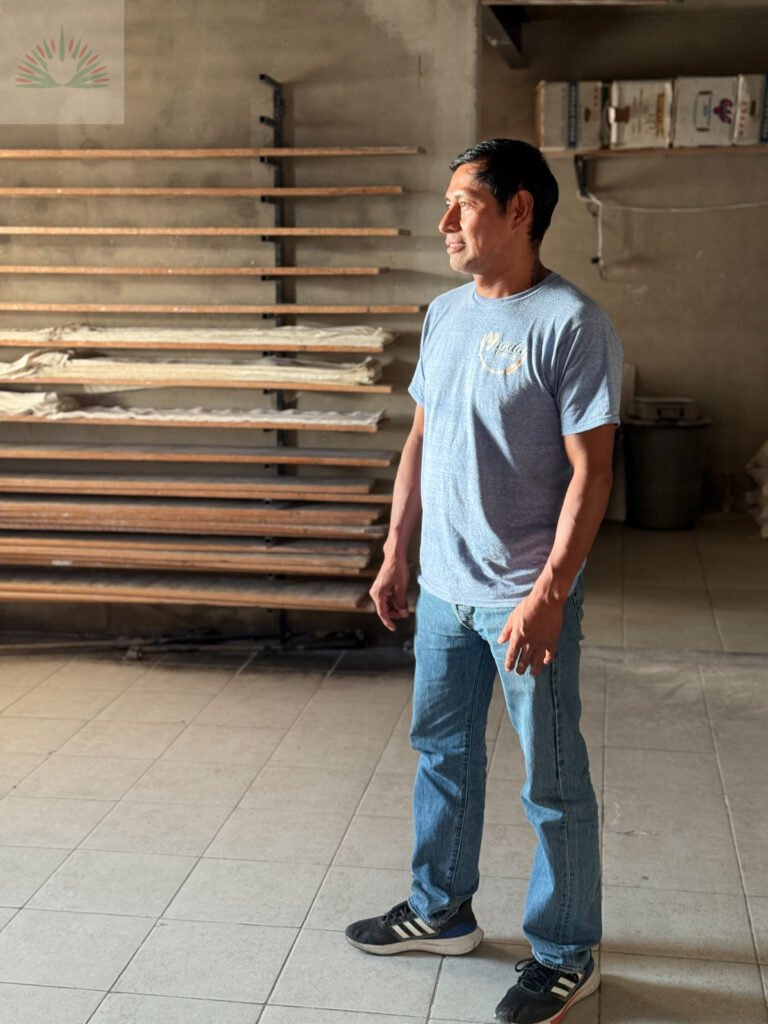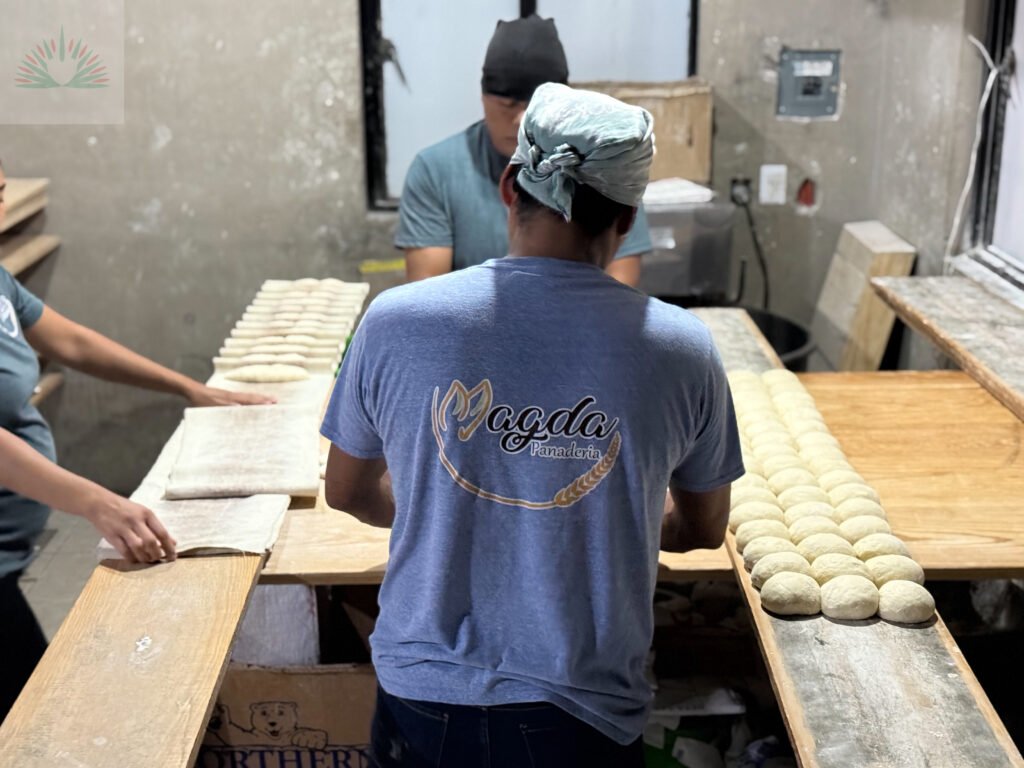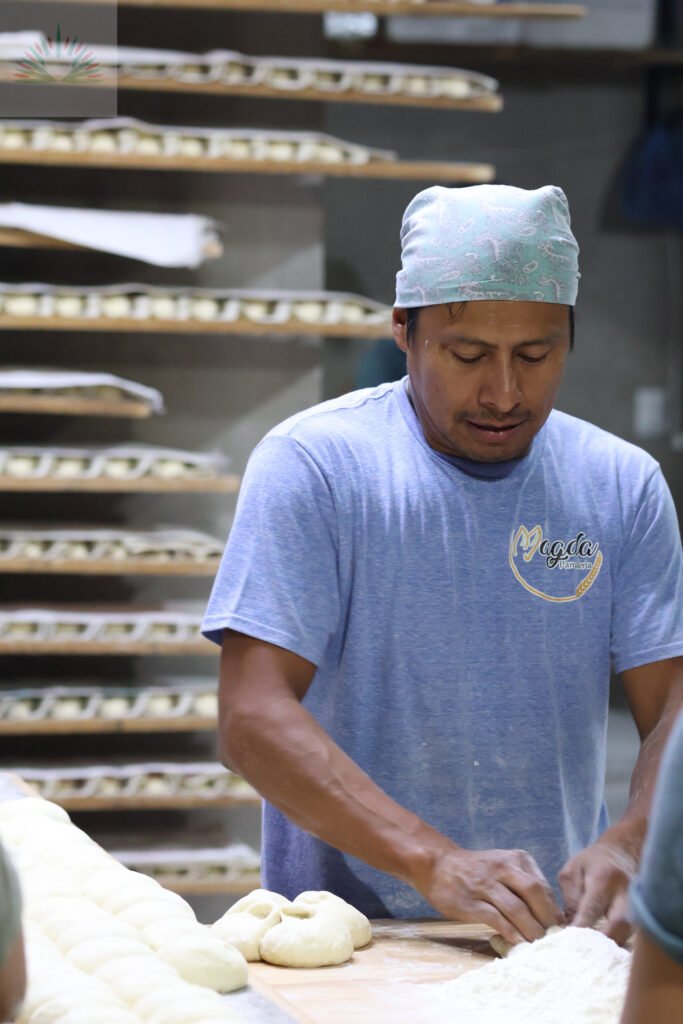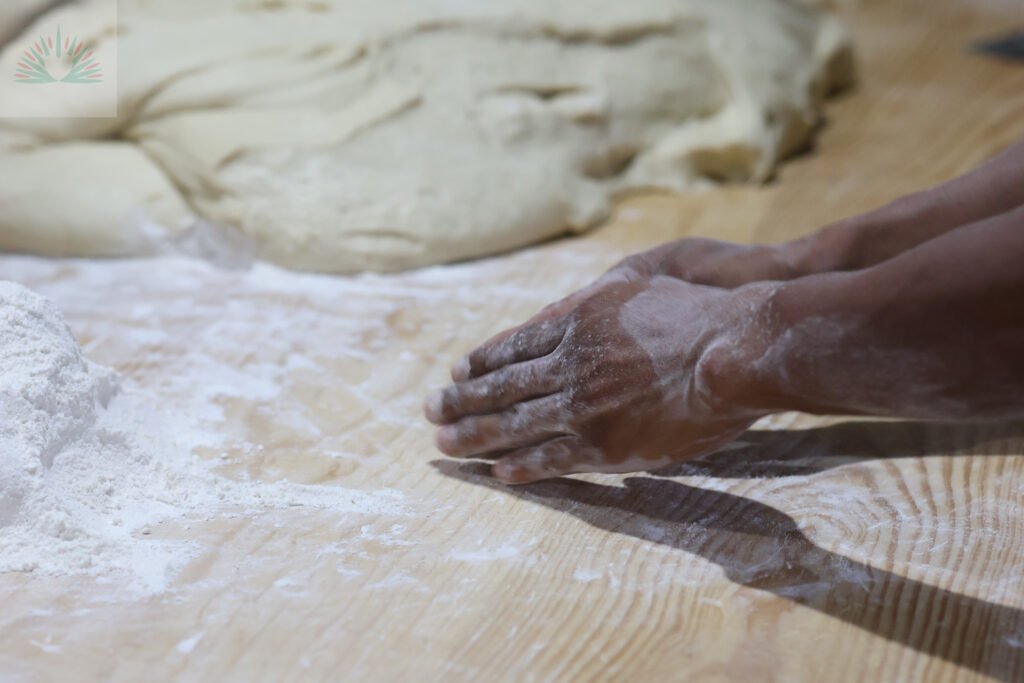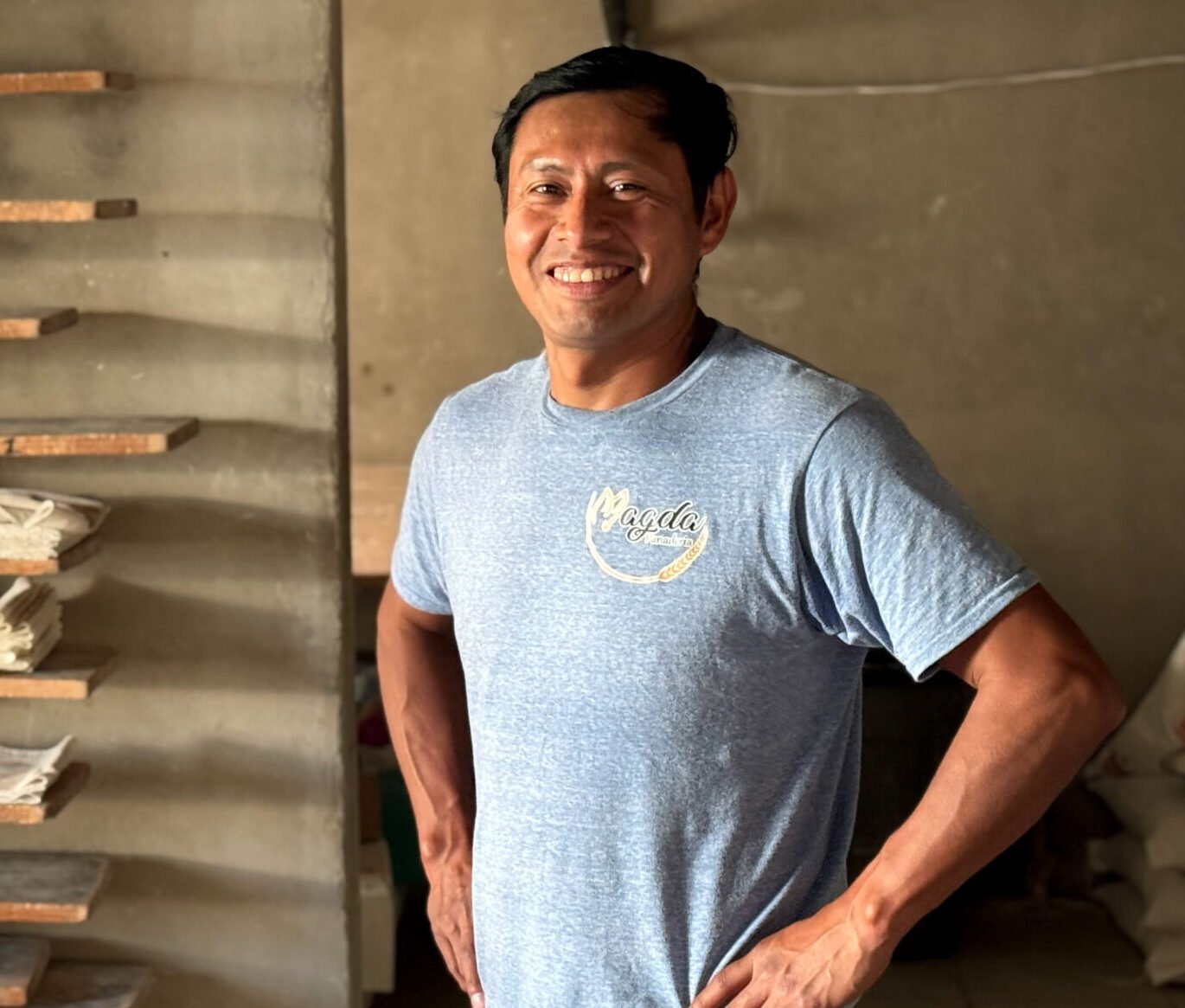From ancient ovens built with thermodynamic precision to sacred dances rooted in resistance, Nicolás shares how a bakery, tradition, and community are deeply intertwined.
What does it mean to truly come home? To find your calling not in something new, but something deeply familiar—woven into your family, your history, your land? I want you to meet Nicolás López—panadero, physicist, danzante, and son of Tuxpan. This is not just a story about bread. This is about legacy. Identity. Curiosity. Spirituality. And a return to the roots that continue to nourish an entire community.
Let Nicolás tell you—in his own words.
“I’m Nicolás López. Nicolás López Silva. I’m a baker—completely a baker. Ninety percent of my time is spent baking… I studied physics, and that’s led me to work in other fields like teaching, research, but dedicating myself specifically to baking has been one of the most important things, and one that I practically dedicate myself to now. That’s my full-time job, regarding baking… Combining my academic profession with my desire to explore the world, with my work as a baker for the family, has made me understand what I do now and how I share it with people, with my family. What processes I learned to be able to create a body of work that’s not only based on tradition, but also on research. And that part made me feel connected to my roots here in Tuxpan, with my family, with my ancestors.”
Like many of us, Nicolás’ life didn’t follow a straight path. He studied physics because he wanted to understand the universe. He dreamed of math, physics, understanding the world. But his hands led him somewhere else—into the dough, the ovens, the family tradition.
“As a child, I didn’t dream of being a baker. It wasn’t something I wanted. My mother and father knew only a few professions, like doctor, lawyer, and architect, which were a useful subject back then. Most of them were the ones most people preferred to study. In my case, no. When I discovered that science was something that interested me, I didn’t want traditional careers like these. …In my case, science pushed me to understand it. I built the oven from geometry, from thermodynamics ot the use of materials—all of this has to do with my science, with, well, with my study of physics.”
Behind every great story is a great mother. Behind every tradition—someone who never let it die.
“What is the significance of the name Magda?”
“It comes from Magdalena, who was my mother. Um, okay, my mother pushed me into all of this, and it’s a way of paying homage to what I learned from her….she had a lot of faith, a lot of confidence that one day I would have something that would mean more than just a job, right? And indeed, I do. It’s more comfortable for me to say I enjoy this than to say I work in a bakery, right? I really enjoy my job, and I think that’s thanks to that, well.”
Before bread ever touched his hands, before science gave him answers, Nicolás López was just a curious kid in Tuxpan, playing dangerously close to flame and fate.
It wasn’t just bread that shaped Nicolás. It was fire—literally.
“One day we were playing “little train”…we were standing one by one, one by one, right? We formed like a line. And we were on top of the flour. Like over there, you see? There are piles of the flour stacked. And we were on the highest part of the pile.
“And we had some blankets to keep from going down, all covered in flour. And suddenly it started to smoke. And I said to my siblings: “Oh look! It’s even very realistic because the engine is smoking.” And suddenly it lights up. I mean, the fire starts. Because we had tried to turn on the lights and they didn’t turn on, but we saw that…and the fire started. And I was in front of the line, in risk of death. This came about and made me directly connected to the bakery. I was a child of about 3, 4 years old. I couldn’t do that jump because if I jumped, there was only a little space where I could hit my head. No, I just waited for someone to help me.
“And sure enough, my dad arrived. He quickly picked me up, folded blankets, and put out the fire like that. So that anecdote has been stuck in my mind since then. It’s probably the beginning of the connection between physics and baking.”
Sometimes, we don’t understand our roots until they almost take us out. A game gone bad as a child ignited something deeper. His connection to craft, to community, to history—was forged in both flame and flour.
And one day, his parents—went on a pilgrimage to a town called Talpa de Allende, and while they were gone, he thought,
“‘Now is the right time to learn.’” So, it was my first week of learning at 8 years old.
“And after the first week, I got sick, and I didn’t touch dough or anything again until two years later, because my father told me, “No, that’s why I don’t want you to work, because you’re too young and because it’s something you probably won’t like.”
“But I did like it, and I began to understand something different about it. Right? My father perhaps wanted to keep us away from this trade because he thought there was more future in a profession like being a lawyer or a doctor.
“That curiosity forced me to learn many things about baking. Little by little, I started getting involved when my dad wasn’t aware, and I learned one thing, then another… and when my dad finally agreed, it was because the workers told him: ‘Oh, well, he knows what he wants to work on, let him work.” So, thanks to the support of the workers, my dad let me start working. And a little while later, my brothers, seeing that I was working, wanted to learn too. Right?
“So, now we’re all dedicated to the bakery, the whole family.”
Tuxpan isn’t just a place—it’s a living culture. A town of 54 traditional festivals, where memory lives in movement, flavor, and faith. It isn’t just where Nicolás is from. It’s the center of a deeper struggle—identity, history, and acceptance.
“Tuxpan is a very traditional town in many ways… we know that it’s a pre-Hispanic settlement.
“That makes us a town that is very….that is forced to maintain its history, its tradition, even though many don’t see it that way or accept it that way. But Tuxpan has very significant roots. People who know Tuxpan know that it’s very likely that 80 percent—I don’t have the exact figures—but 80 percent of the people are brown-skinned and have indigenous features.
“I struggled a lot with that. And I always used to ask myself, ‘why do I have to be this way? Why do I have to go through this? Why me? Why am I not like so-and-so? Why am I not him? Why not…?’
‘And it was difficult to accept… and not see that this isn’t a punishment nor is it a benefit. But the problem was basically with other people, that they don’t accept each other because they see them a certain way. And maybe it’s humanities struggle, ‘the other’. Not accepting that there are different people. That there are people who don’t think the same.”
“That made me fight. And it made me struggle in many areas of my life. The first battle was my own. Accepting who I am. It took me 17 years. After that battle, and after having won the battle, I now feel very proud—my family, my people, Tuxpan. I even boast about it.”
Through bread, through dance, through spiritual connection and scientific thought, Nicolás returned to where he began—and found something more.
“What is so important, is that my life made me come back here and understand that no matter where you go, the important thing is to be satisfied in a life that gives you peace and tranquility.
“In that way, I can define happiness. And I feel like my happiness is here now, with my family, with my wife, with my children, with my work, with my siblings. This community has embraced me again.
“I believe that when you feed, or are part of that process in the chain that develops food so that someone else can eat and feed themselves, for me, it is so important, because we all need to eat. That little bit that you offer something to someone, that’s what makes me feel like I’m on the right path.”
In the heart of Jalisco, bread isn’t the only thing made by hand and passed through generations. Tequila is another sacred craft—one that shares much with baking. Both require patience. Fire. Transformation. And the belief that time reveals flavor, strength, and soul.
“So, I prefer tequilas with a stronger, more natural flavor.
“We have a mezcal plant nearby. It’s named, based on the process, Tlachica, similar to the place where it’s distilled. And it’s La Chicero that makes it.
“So, trying a mezcal distilled from here, which is also known as ‘Raicilla’, has a very different flavor than tequila in this case. It tastes more like wood, because when they’re making the distillate, the smoke also envelops itself with the flavor of the distillate. And you get a slightly smoky flavor. I love that.”
Whether it’s poured during a celebration or sipped in silence, tequila—like Nicolás’s bread—reminds us of where we come from and who we share the journey with.
Nicolas’ story is one of curiosity, family, and fire, reminding us that tradition isn’t frozen in time—it’s alive in every movement, every loaf, every ritual.
But that was only the beginning.
After a night of festival, dance, and connection, he was lit up from the inside out, and we sat down again, the morning after. The energy of community still lingering in his voice.
“I went to University in Guadalajara, and after studying and doing various things, I decided to return precisely on the date of the dance and began to document everything.
“When I finished, I said, ‘okay, the battery’s dead, I’m done with this,’ I put everything away, and decided to go precisely to an altar close to where I was at that moment. ‘Today, I’ll just enjoy myself—I’m not even going to get involved over there, or anything…’ Well, I took a chair that was nearby and sat in front.
“When they (the dancers) came back in front of the altar, I stayed in front of it, exactly where they turned around. And it was one of the rattles, not even one of the chayacates(traditional rattles). So I’m sitting, and suddenly the drum started and they began to dance. They go and do the first turn, when they come back, about halfway between them, me and the altar, half of them came… and the chair began to vibrate. And my feet started to feel the vibration.
“And I started to cry. And I realized exactly what they had been telling me: “These are your roots, right? What you’re here feeling now… this is your community, this is your story.”
‘What need do you have to be searching for something else?
“And I quickly connected to that vibration, that sound of the drum, that flute. And they quickly connected me to the heart of this tradition. So now when I listen… not to the drum, not to the rattles, when I hear: “Hey, we’re ready. Let’s start now!”… my heart begins again…(beats chest as if it were a beating heart)”
What happens when a drumbeat becomes a heartbeat? When dance becomes a prayer?
“Every time when I end up at an altar, I ask for several things. But the first thing I ask for is energy. I always, always ask, ‘Help me. I would like to end the day dancing. I want to dance my way to the last altar.’
“And honestly, on a couple of occasions, I’ve felt as if someone embraced me and lifted me up. I don’t know who it is, haha. I don’t know if it’s something religious… I don’t know if it’s God or maybe the local gods from around here. I don’t know who it is. But I’ve felt it—yes, I’ve felt it.
“From being on my knees… and sometimes I find it hard to get up from that position…I feel like someone comes—like, under my armpits—and as if they lift me up. And they say to me: ‘Keep going. We’re here helping.’”
For Nicolás, dance is not performance—it’s presence. The altar is the heart of it all. The tradition is sacred. A way to carry forward memory, meaning, and reverence. For Nicolás, it’s not just about dancing. It’s about who carries the story next.
“I think a lot of people dance just for the sake of dancing.
“And when it comes to what needs to be done, it’s about finding people who are interested in spreading this information—but it probably shouldn’t be just us.
“And suddenly, people ask: ‘And who are you?’ You… how do you know about this?’
“Well, we also find ourselves having to explain to them, ‘Ah, so who am I? I’m someone who has truly taken an interest in understanding the foundation, the origin, the root of this entire celebration.’”
Tradition without understanding becomes repetition. But Nicolás sees potential in each movement, each offering, to carry cultural memory forward.
“I think it’s important to understand the fundamentals, to understand the roots. And if you have a particular contribution, add it, but with your own experience and information. Don’t let it go against all that simply because you’re a rebel, because you’re a revolutionary. Right?”
The next generation will shape what remains. But Nicolás asks for thoughtful transformation—not abandonment. For the next generation to carry the torch, they must first understand what lights it.
“So, you can create your own dance, and you can dress however you like. But if you tell me it comes from this—from the roots—I mean, it’s not enough to just say:
‘Oh, all the chayacates go dressed, they go hidden with a mask, and the mask can be anything.’
And where does it come from?
If you maintain solid roots in what you’re doing, and even if it’s new, even if it’s your own creation, if you have a solid reason and argument for what you’re doing—then keep doing it!”
Tradition can be remixed. But it must be rooted. In the details—masks, costumes, altars—there is power. Because when the form carries meaning, the ritual becomes alive.
The dance of Tuxpan is not just movement—it’s resistance, memory, and a living history. For Nicolás, each step carries the strength of ancestors and the coded language of revolution.
The sound of rattles. The shimmer of ribbons. The stomping of feet echoing like thunder on the earth.
These aren’t just performances—they’re memories in motion.
“In particular, The Dance of the Sonajeros (Dance of the Rattles) is much older.
“The Sonajeros (Rattle Dancers), their rattle, it’s a stick that used to be the club that people would go to war with, right? So, this dance is a warrior dance.
“Their vest, it’s a protective breastplate. These ribbons were different types of colors that they used both for camouflage and to identify which squadron you were in…
“This dance is a very striking one. It’s, ‘I’ll show you who I am. I’ll show you this power I have. I’ll show you this energy I bring. I come to fight. I am very powerful. And my army is very big…”
“It has to do with something that many people don’t know—that Tuxpan was oppressed by “Caciques”, by people with other kinds of power, specifically the colonizers.
“This dance is not just a local expression, it’s practiced in many places. And what everyone agrees on—a shared trait—is that the dancers have to dress like the oppressors, right? The white people.
“That’s why the masks are of white people: light-colored eyes—blue, green—blonde, white, or flashy hair. We use golden hair. And dress elegantly, right? This dance was born to mock them and to say what you didn’t dare say to them. Because when you wear a mask, they don’t know who is dancing.
“It was also forbidden to remove your mask to avoid problems afterward. Because as long as you were masked and within the festivities, nothing would happen—but once you left, yes, you could get into trouble.
“So, this dance is about ridiculing the oppressor, not ourselves…”
It’s loud. It’s proud. And it holds deep meaning for a people who refuse to forget where they come from. Through satire and symbolism, dancers reclaim their dignity. Their history.
“Realizing that dancing isn’t just about going to hang out—going to drink punch, have beers, eat. No.
“It involves tradition. It involves preserving a manifestation of who you are. And who you are must be respected.
“The essence of being from Tuxpan isn’t just about saying, ‘Oh, I have so many festivals. I’m like this because of that. When May festivals come around, we act this way.’ Rather, it’s more about saying that a social organization—a community—must be respected. It must maintain unity.
“We are not just any town. We don’t come from just two or three years ago, or even two or three decades ago. Tuxpan is very old.
“And I believe that respecting who we are, respecting all this history, is not just about going out to dance. It’s about expressing the deeper meaning of what it means to develop this tradition, to expand the knowledge of our entire history.”
Nicolás doesn’t want to be a star.
He wants to be a seed. In sharing his story, Nicolás is not just protecting tradition—he’s inviting others into it. Into the mystery, the movement, the memory.
“I’m very grateful that people from other places, other cultures—people who aren’t from here or don’t live right next door— are showing what I’m talking about now: this curiosity to know, this curiosity to see, this curiosity to preserve.
“But I keep insisting that if we accept ourselves as we are, we will be much better off than we’ve been. Accepting that someone else exists who is not me is very important, because we’ve all become too individualistic everywhere, right?
“ ‘Only me.’ ‘Only me.’ ‘Only me.’ ‘Me.’
“’I don’t care what the other person wants.’ ‘I don’t care who the other person is.’ ‘I don’t care what the other person creates.’
“In the end, we all live in the same world. And if I don’t respect what someone else does, I’ll share in the blame in the future.”
Respect, curiosity, and community. This is what Nicolás stands for.
In Tuxpan, tradition isn’t an artifact—it’s alive.
And Nicolás is one of its many storytellers, bakers, dancers, and keepers. From the heat of the oven to the rhythm of the danza, Nicolás lives at the intersection of tradition and transformation. He is one of many keepers of Tuxpan’s spirit.
This is what 365 Days of Tequila is all about—listening deeply, celebrating widely, and honoring the richness of Mexico through its people.
